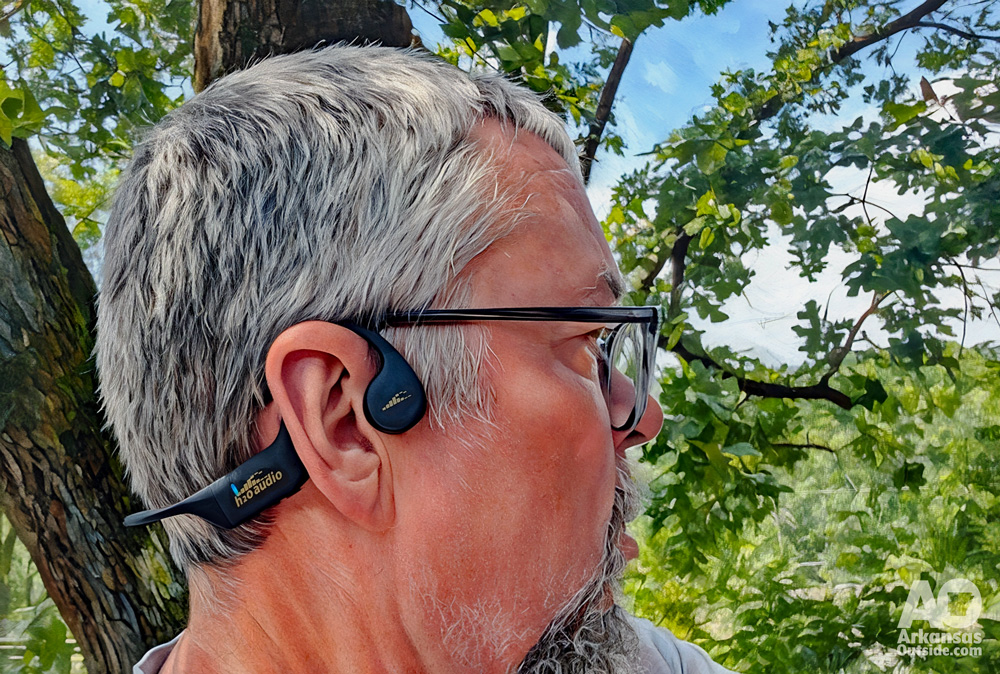Heading out for a trail run, hike, bike ride, or paddle? A good playlist or podcast can take your outdoor adventure from “nice” to “next-level.” But before you crank up your favorite jams for all the forest (and fellow hikers) to hear, let’s face it—your music might be awesome to you, but not everyone shares your love for ‘90s boy bands or death metal. How you listen matters just as much as what you’re listening to. Bluetooth speakers had their moment, but bone-conducting headphones are the new MVP—smarter, safer, and way more respectful to nature and your trail neighbors. Here’s why they win.
1. Situational Awareness is Key
One of the most critical concerns when adventuring outdoors is staying aware of your surroundings. Bone-conducting headphones sit outside the ears and transmit sound through your cheekbones, leaving your ears open to ambient sounds. This means you can still hear approaching cyclists, wildlife, traffic, or an oncoming storm—all without pausing your playlist.
In contrast, Bluetooth speakers broadcast sound into the open air, which can drown out these environmental cues for both you and others nearby. And unlike earbuds, bone-conducting headphones let you remain fully alert while enjoying your tunes.

2. Respect for Others
Bluetooth speakers can turn a serene natural setting into an unwanted concert for everyone within earshot. Public trails, campsites, and waterways are shared spaces. What sounds like your favorite song might be a noisy disruption to someone else’s peaceful escape.
Bone-conducting headphones solve this with a personal listening experience that doesn’t invade anyone else’s space. You get your soundtrack; they get their silence.
3. Legal and Trail Etiquette Friendly
More trails, parks, and organized races are enforcing rules against the use of open-air speakers, especially on singletrack or in areas where noise pollution can harm wildlife. Some races even prohibit traditional earbuds for safety reasons. Bone-conducting headphones, however, are often permitted since they allow for ambient awareness and don’t disrupt the environment.
4. Compact and Adventure-Ready
Unlike bulky speakers that take up pack space and require strategic placement, bone-conducting headphones are sleek, lightweight, and designed for movement. Most are sweatproof or waterproof and have long battery life, making them ideal for endurance sports and rugged conditions.
You can wear them while biking without compromising helmet fit, while running without fussing with wires, and even while paddling without worrying about dropping a speaker into the water.
5. Private Listening Without Isolation
Whether you’re listening to GPS directions on a backcountry trail or jamming out to your power playlist, sometimes you don’t want to broadcast your audio. Bone-conducting headphones keep your audio experience private without the isolating effect of in-ear buds or the outward blast of a speaker.
This is especially useful for group activities—you can enjoy your audio without checking out of the social or natural environment.
6. Take Your Tunes in the Water
Waterproof bone-conducting headphones are a game-changer for swimmers, paddlers, and lake loungers alike. Since they don’t go in your ears, you can still hear the world around you—like lifeguards, boaters, or your friends shouting about the epic cannonball they just did—while enjoying your favorite playlist underwater. Whether you’re doing laps in the pool or floating in the lake, these headphones let you soak up the sounds without missing a beat.

What I use
On a personal note, while I’ve built a reputation around Arkansas for my love of the outdoors, my passion for great music runs even deeper—though I fully admit my playlists might not be everyone’s cup of tea. I’m currently on my third pair of bone-conducting headphones. My first set wasn’t waterproof (oops), the second was waterproof but felt like strapping bricks to my head for lap swims. Now I’ve upgraded to H2O Audio Tri Pro 2s, and I’m obsessed—they store music internally for pool time and switch to Bluetooth for hikes, rides, and runs. One pair, all the adventures.
Final Thoughts
Outdoor adventures are all about balance—between immersion in nature and connection to technology, between personal enjoyment and public space. Bone-conducting headphones strike that balance beautifully. They offer a safer, more respectful, and more practical way to enjoy audio in the outdoors compared to Bluetooth speakers. So next time you head out on a trail or waterway, leave the speaker behind and strap on some bone-conducting headphones. Your fellow adventurers—and the natural world—will thank you.






